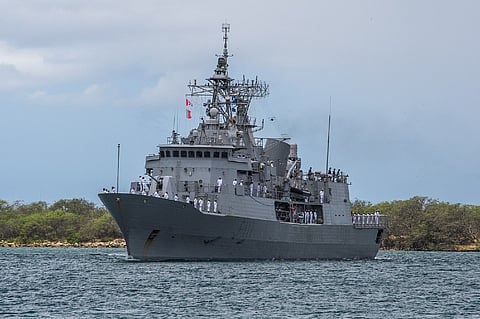

The Royal New Zealand Navy (RNZN) is responsible for maritime security within the nation's 4.3 million square-kilometre EEZ, as well as in the waters surrounding the New Zealand offshore territories of Tokelau, Cook Islands, Niue and the Ross Dependency. The service also punches above its weight in the international maritime arena, and has seen active service in recent years in the Persian Gulf, Papua New Guinea and East Timor, as well as taking part in multi-national disaster relief and peacekeeping operations.
A programme of upgrades and acquisitions, including the commissioning of the RNZN's biggest-ever vessel, is set to substantially boost the capabilities of this small but modern force.
The RNZN escort inventory, designated the "Combat Force," consists of the 3,600-tonne, Australian-built, Anzac-class frigates HMNZS Te Kaha and HMNZS Te Mana. The year 2018 saw the commencement of a major upgrade of both these vessels in Canada.
The upgrade contracts involve defence companies from the US, Australia, Canada, UK and New Zealand. Te Kaha is currently undergoing post upgrade sea trials.
The ships' air defences are to be greatly strengthened by the installation of the Mach 3 Anglo-French Sea Ceptor weapon system to replace their Sea Sparrow missiles. The performance of the ships' existing sonar system is being enhanced by the fitting of a broadband sonar advanced processing system.
A new torpedo defence system is being fitted, together with modern inertial navigation equipment and two Furuno 3000 series X-band radar systems.
The commissioning in 2007 of the 9,000-tonne multi-role vessel HMNZS Canterbury brought a new dimension to RNZN operations, as it enabled the service to take a lead role in domestic and regional disaster relief and stabilisation operations. Built jointly by Merwede Shipyards in the Netherlands and Tenix (now BAE Systems) in Australia to a civilian ferry design, the ship can carry 250 troops and their vehicles, two landing craft, and up to four helicopters and has quite extensive medical facilities.
A somewhat feeble main armament of a single 25-millimetre cannon is fitted in an exposed forward mounting.
Canterbury has so far led an active operational life, but has been plagued by technical problems and poor seakeeping qualities, which have required much remedial work.
Late July 2020 saw a significant event when the RNZN took delivery of its biggest-ever vessel, the 26,000-tonne, 173-metre fleet replenishment tanker HMNZS Aotearoa. The 16-knot, diesel-electric powered ship was built by Hyundai in South Korea. The tanker is ice-strengthened to enable operations in support of New Zealand's Antarctic monitoring and research facilities.
Capabilities include the underway replenishment of RNZN and allied warships with diesel, aviation fuel, water, ammunition and dry stores. NATO specification replenishment rigs are fitted port and starboard, and up to 22 containers can be embarked. There is also a small onboard medical facility.
Self-defence armament is a Phalanx close-in weapon system and two Mini-Typhoon remotely fired machine guns. An aft flight deck with hangar enables helicopter operations.
Aotearoa is a valuable new strategic asset for New Zealand. The ship will be a force extender for RNZN warships, and will be able to enhance the service's frequent joint operations with the Royal Australian Navy and to facilitate further co-operation with other leading regional navies.
The RNZN relies heavily upon a pair of 1,900-tonne offshore patrol vessels (OPVs), HMNZS Otago and HMNZS Wellington, for routine offshore patrol work. Constructed by Tenix/BAE Systems in Australia, they feature a Typhoon 25-millimetre cannon and surveillance radar, and can, like the frigates, operate a Super Seasprite helicopter armed with Penguin anti-shipping cruise missiles.
The RNZN offshore inventory is completed by the Norwegian-built hydrographic survey/dive support vessel HMNZS Manawanui.
The service operates two Lake-class inshore patrol boats, HMNZS Taupo and HMNZS Hawea, on second-line duties. Two sister ships have been withdrawn from service.
Some reports have claimed that they were unsuitable for the rough conditions often found in New Zealand waters, while others said that the service cannot muster sufficient personnel to operate them. The long-term fate of the two surviving vessels is uncertain.
Looking to the future, the RNZN has ambitious plans to further extend its long range capabilities by constructing two heavy lift ships to supplement – and, by 2030, replace – Canterbury and by acquiring a Southern Ocean patrol ship to be built largely to civilian specifications by 2027. There are also plans for a new type of shipboard helicopter to replace the Super Seasprite, currently operated for the service by a maritime-specialised squadron of the Royal New Zealand Air Force.
